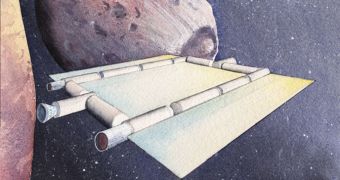An analysis of the most feasible, possible ways of traveling through space has revealed that using spacecraft powered primarily by water to explore Mars and other locations in the solar system might open up new possibilities in space exploration.
Flights to the Red Planet, Venus, the Saturnine moons Enceladus and Titan, and the Jovian moon Europe could become a lot cheaper by using such vehicles, the conclusions of the new report show.
According to the paper, a trip to Mars using this technology could cost as little as launching a space shuttle costs today – a couple hundred million dollars. In either case, the funds required for such an endeavor will reach several billion dollars, as estimated today.
In addition, the new type of space explorers could be kept in Earth's orbit while not in use. This will have the advantage of making trips even cheaper. In addition, this approach would eliminate the most important part of the costs, which is that associated with the actual launch.
Researchers believe that, while a water-powered spacecraft is just a drawing board concept today, it could become a reality in the near future, if the will to construct one can be found.
“It's really a systems integration challenge. The fundamental technology is already there,” explains Brian McConnell, the lead author of the study, and a software engineer and technology entrepreneur.
He explains that the space coaches his team envisions would feature electrothermal engine. Sunlight would heat water to high temperatures, and the Steam produced in this manner would then be converted to thrust by releasing it through special nozzles, Space reports.
This type of propulsion system is ideally equipped to support sustained, low-thrust mission needs, such as those of a trip to Mars. Furthermore, the system's functionality could be augmented by the addition of smaller, conventional thrusters, if needed.
McConnell explains that the living quarters would be made of inflatable modules, such as those already developed by Bigelow Aerospace. They would be interconnected by service modules, and shielded from cosmic radiation by a layer of water.
Given that the modules would be made of fabric, it could be feasible to include water in their composition too. When the spacecraft reaches the cold environment of outer space, the walls would freeze stiff, providing additional stiffness and resistance to the vehicle.
Certain parts of the ship could also have artificial gravity, experts say. This can be achieved by allowing the spacecraft to rotate as it moves forth. The effect will not be fe;t throughout the ship, but it could make itself felt inside crew quarters, common areas and scientific modules.
“Altogether, this reduces costs by a factor of 30 times or better,” McConnell says. He estimates that it would take less than $1 billion to reach Mars using this technology. For comparison, the new rover that NASA will send to the Red Planet later this year costs over $2.5 billion.

 14 DAY TRIAL //
14 DAY TRIAL //